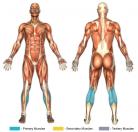Calf Raises (Machine: Leg Press)
- Adjust the leg press back rest so that you are firmly in place when seated (and thus not sliding). Normally this entails adjusting the seat to be more upright.
- Ensure that the weight sled is set low enough so that you can raise the weight far enough to lower the weight-retention handle(s) without raising off the seat. Then add the desired weight amount, and set the safety pin(s) in place in case your feet slip off the feet plate.
- With only the balls of your feet on the weight plate (your heels should be hanging off), press the weight sled upward by straightening your legs, and then release the weight-retention handle(s). Your knees should remain slightly bent (i.e. you should extend your legs just short of being locked-out). This is the starting position.
- Press the weight upward by pointing your toes until you can press no more (so that you calves are entirely contracted), while exhaling throughout the movement. Remember to keep a slight bend in your knees.
- Lower the weight downward by allowing gravity to move your toes back toward you, while inhaling throughout the movement. You should feel a deep stretch. And, again, remember to keep a slight bend in your knees.
- Repeat steps 4-5 for as many repetitions as are desired, and, once complete, move the weight retention handle(s) back into the locked position.
As with other calf exercises, if building calf mass is the goal, then lifting with heavy weights is almost unequivocally required. The calves are usually considered to be the most arduous muscle of the body to develop because they are accustomed to being worked constantly by the mere act of ambulating from place to place. The calves are capable of a notably high quantity of work. Getting results in calf strength, definition, or mass will, for most, require mental fortitude and strong, unwavering volition.
Likewise, if building calf endurance is the goal, then lifting with unusually high repetitions is almost absolutely required. The same reason as above applies.
In theory, the feet can be positioned in different ways to change the focus of stress on the calf muscles. By pointing the feet outwards it is possible to isolate the inner calf (medial gastrocnemius) and, conversely, by pointing the feet inwards it is possible to isolate the outer calf (lateral gastrocnemius). For most, it will take practice to achieve this result, even with proper foot placement. Separating the stress put on the gastrocnemius from the soleus is much easier to accomplish. (e.g. Standing calf raises will work the gastrocnemius more, while seated calf raises--where your knees are at a 90 degree angle--will work the soleus more).
The weight should be such that you can move through a complete range of flexion (i.e. raise and lower the weight fully upward and downward) for the majority of the repetitions. Once your calves are exhausted, finish you set by executing partial repetitions. The muscular burn you experience will likely be intense, but if you want optimal results it the price that must be paid.
Keeping a slight bend in your knees not only helps to target the calves better, but it also greatly helps in preventing hyperextension injuries. Therefore, keep a slight bend in your knees at all times with this exercise, do not lock them.





